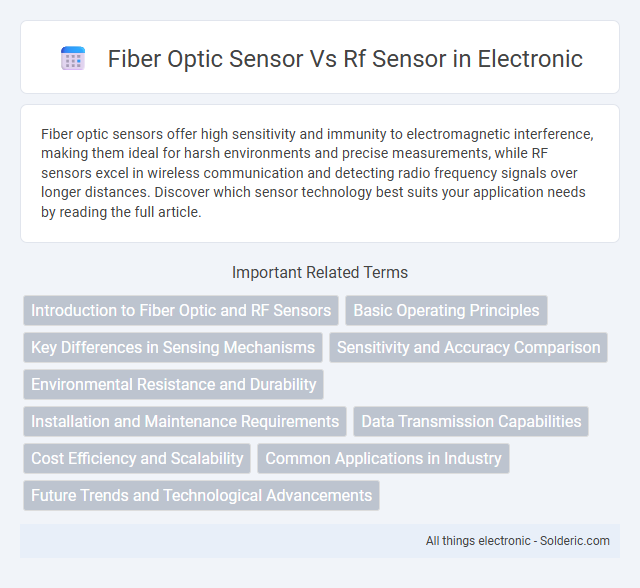Fiber optic sensors offer high sensitivity and immunity to electromagnetic interference, making them ideal for harsh environments and precise measurements, while RF sensors excel in wireless communication and detecting radio frequency signals over longer distances. Discover which sensor technology best suits your application needs by reading the full article.
Comparison Table
| Feature | Fiber Optic Sensor | RF Sensor |
|---|---|---|
| Operating Principle | Light modulation through fiber optic cable | Radio frequency signal transmission and reception |
| Sensitivity | High sensitivity to physical changes (strain, temperature) | Moderate sensitivity, influenced by RF environment |
| Interference | Immune to electromagnetic interference (EMI) | Susceptible to EMI and signal noise |
| Range | Long transmission distances (up to tens of kilometers) | Limited range, typically short to medium distances |
| Bandwidth | High bandwidth for data transmission | Lower bandwidth compared to fiber optic |
| Durability | Robust, resistant to harsh environments | Less durable, affected by environmental conditions |
| Cost | Higher initial installation cost | Lower setup cost |
| Applications | Structural health monitoring, temperature sensing, telecommunications | Wireless communication, RFID, radar systems |
Introduction to Fiber Optic and RF Sensors
Fiber optic sensors utilize light transmission through optical fibers to detect changes in temperature, pressure, or strain with high sensitivity and immunity to electromagnetic interference. RF sensors operate by emitting and receiving radio frequency signals to measure variables such as motion, proximity, or material properties, making them effective for wireless sensing applications. Your choice between these technologies depends on factors like environmental conditions, signal range, and the need for precision or electromagnetic compatibility.
Basic Operating Principles
Fiber optic sensors use light signals transmitted through optical fibers to detect changes in temperature, pressure, or strain by measuring variations in light intensity, phase, or wavelength. RF sensors operate by emitting and receiving radio frequency waves to identify the presence, distance, or motion of an object based on signal reflection and energy absorption. Your choice depends on the application requirements, as fiber optic sensors excel in high sensitivity and immunity to electromagnetic interference, while RF sensors offer longer-range detection and wireless capabilities.
Key Differences in Sensing Mechanisms
Fiber optic sensors detect changes in light properties such as intensity, phase, polarization, or wavelength within an optical fiber, enabling precise measurement of physical parameters like temperature, strain, or pressure. RF sensors operate by transmitting and receiving radio frequency signals, detecting variations in electromagnetic fields caused by environmental changes or object presence. The core difference lies in fiber optic sensors relying on light modulation in a guided medium, whereas RF sensors depend on electromagnetic wave propagation and reflection in free space.
Sensitivity and Accuracy Comparison
Fiber optic sensors offer superior sensitivity and accuracy compared to RF sensors due to their immunity to electromagnetic interference and high-resolution signal detection capabilities. These sensors provide precise measurements in volatile or electrically noisy environments, enhancing reliability for critical applications. Your choice of sensor should consider the required precision and environmental conditions to optimize performance.
Environmental Resistance and Durability
Fiber optic sensors exhibit superior environmental resistance and durability compared to RF sensors, as they are immune to electromagnetic interference, corrosion, and extreme temperatures. Their construction using glass or plastic fibers ensures longevity and stable performance in harsh environments such as industrial or underwater settings. Choosing fiber optic sensors enhances reliability and reduces maintenance costs in challenging operational conditions.
Installation and Maintenance Requirements
Fiber optic sensors require precise installation with careful alignment of fiber cables, demanding skilled technicians and specialized tools, while RF sensors offer more straightforward installation due to wireless or simple wired connections. Maintenance for fiber optic sensors involves regular inspection for physical damage and cleaning of connectors to prevent signal loss, whereas RF sensors need periodic checks for interference and battery replacement if wireless. Your choice between the two should consider the complexity of installation environments and ongoing maintenance resources.
Data Transmission Capabilities
Fiber optic sensors offer superior data transmission capabilities with high bandwidth and immunity to electromagnetic interference, enabling the transfer of large volumes of data over long distances with minimal signal loss. RF sensors, while effective for wireless communication, typically suffer from limited bandwidth and are more susceptible to noise and signal degradation in electrically noisy environments. The precision and speed of fiber optic sensors make them ideal for applications demanding high-resolution and real-time data processing.
Cost Efficiency and Scalability
Fiber optic sensors offer higher initial costs due to specialized materials and installation but provide long-term cost efficiency through low maintenance and immunity to electromagnetic interference, reducing downtime and repair expenses. RF sensors typically have lower upfront costs and easier installation, making them scalable for large deployments, but may incur higher operational costs from signal interference and environmental factors. Your choice depends on balancing initial investment with long-term scalability and maintenance requirements specific to your application.
Common Applications in Industry
Fiber optic sensors are extensively used in industries requiring precise temperature and strain measurements, such as aerospace, oil and gas, and structural health monitoring. RF sensors dominate in wireless communication, radar systems, and remote sensing applications, leveraging their ability to detect electromagnetic signals over long distances. Both technologies enhance industrial automation, with fiber optics excelling in harsh environments and RF sensors enabling real-time data transmission.
Future Trends and Technological Advancements
Fiber optic sensors are rapidly evolving with advancements in nanotechnology and enhanced materials, enabling higher sensitivity and immunity to electromagnetic interference, which positions them as key players in future industries such as aerospace and healthcare. RF sensors continue to benefit from improvements in miniaturization and signal processing algorithms, expanding their application in wireless communication and IoT devices. Your choice between these sensors should consider upcoming trends like integration with AI for smart diagnostics and the growing demand for real-time, high-precision monitoring systems.
fiber optic sensor vs rf sensor Infographic

 solderic.com
solderic.com